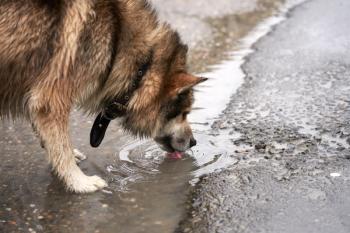
The complete physical exam: empowering your team to do more than just a TPR

Learn tips and pearls for ensuring a comprehensive physical exam
Content submitted by Thrive Pet Healthcare, a dvm360® Strategic Alliance Partner
When a patient and their pet parent arrive at your hospital, it is imperative that veterinary technicians and assistants gather a complete history from the client and perform a thorough physical assessment on the patient. With many of us experiencing a high case load in our hospitals and busy being the word that dominates our workdays, it is not uncommon for us to rush through an initial assessment of our patients by obtaining only a few key vital signs when first assessing them, which typically encompasses a baseline temperature, pulse, respiration (TPR). While important parameters, limiting ourselves to a TPR may lead us to missing significant pieces of information about the medical condition of a pet which as we all know can be subtle, yet profound.
The information we obtain and communicate is necessary to the development of a prognosis and treatment plan by the attending clinician. There are additional vital signs that need to be assessed to “paint the complete picture of the patient” for the clinician. Keep in mind that typically, we have only the client’s observations and the physical findings of our patient to lead us in the right direction for prognosis and treatment. Subtle and obscure observations obtained and communicated by the veterinary technician and veterinary assistant can and will affect the outcome of a patient’s presenting complaint. Not only do we provide valuable baseline parameters for future evaluation of trends, but we also provide an opportunity to prioritize and triage those parameters that are most concerning and will often recognize those abnormal parameters before the patient becomes clinical for those abnormalities.
Read on to review and revisit all the components that, when combined, help us obtain foundational information on the condition of our patients.
Signalment
Gather a complete description of the animal:
- Species, breed, age, sex, reproductive status, other distinguishing characteristics
- Always double-check client reported information (sex, age, etc.)
History (Hx)
A complete history includes origin, environment, diet, medical history, breeding history, vaccination status, and current medication.
General appearance
Observe the animal from a distance and up close before handling:
- Reaction to stimuli and surroundings
- Posture
- Gait: watch the animal walk towards you
- Breathing effort and pattern
- Airway sounds
- Stridor: Loud breathing = large airway disease (nasal passages, trachea, larynx/pharynx)
- Inspiratory noise or difficulty = extra thoracic upper airway disease (especially the larynx)
- Expiratory noise or difficulty = intrathoracic tracheal disease
- Stertor: low pitched “snoring” of nasopharynx
- Stridor: Loud breathing = large airway disease (nasal passages, trachea, larynx/pharynx)
- Bleeding status
- Observed pain
Level of consciousness/mentation (LOC)
Assess attentiveness and reaction to environment. Include the owner’s observation of the patient at home as part of your history, as patient’s LOC and mentation can change upon arrival at the hospital due to stress, anxiety, pain, and a variety of other factors.
Changes in their status can be related to perfusion, changes in intracranial pressure due to trauma, toxicities, metabolic changes, and/or neurologic changes or disease. Getting a baseline evaluation is imperative as a decrease in LOC and/or mentation can indicate an emergency.
Listed below are the descriptions used to describe LOC and behavior. Evaluate the patient from a distance first and then as part of your physical examination, where you can provide stimulus and evaluate their response up close:
- BAR: Bright, Alert and Responsive to stimuli
- QAR: Quiet, Alert and Responsive (still aware, but not as happy/active)
- Depressed/dull/lethargic: patient prefers to sleep, response to stimuli is normal
- Hyperactive, hysterical, or irritable: responses to stimuli are inappropriate
- Obtunded: slow response to stimuli
- Stuporous: only responds to noxious stimuli
- Comatose: no reaction to all stimuli, noxious and other
Body weight
Weigh all animals in kilograms. Use a baby scale for animals under 10 kg and a floor scale for those over 10 kg. Keep in mind most drugs are dosed in mg/kg an 1 kg is equal to 2.2 lbs.
Cardiovascular evaluation
Assess heart rate, rhythm/pulse rate, and quality. Every technician should have a good stethoscope and perform auscultation in as quiet an environment as possible with the patient standing and calm (ideally). Place your stethoscope at the apex of the heart, typically where you can feel the heart beat strongest against your hand, on the left side of the thorax at the fifth intercostal space. Auscult ventral (especially in cats) and right side as well. Determine the heart rate by counting the beats in 15 seconds and multiply by 4:
- Normal:
- Canine 60-140 bpm
- Feline 170-220 bpm
- Determine the rhythm, listen for a full 60 seconds.
- 2 distinct heart sounds should be heard
- The “lub” (S1) when the atrioventricular valves close
- And the “dub” (S2) when the semilunar valves close.
- Any additional sounds may indicate the presence of a heart murmur
- Sinus rhythm has regular beat with a normal rate
- Sinus arrhythmia has a normal to slow heart rate and is characterized by an increase in heart rate during inspiration and a decrease in heart rate during expiration
Perform a pulse quality and synchronicity assessment: palpation of a peripheral arterial pulse (both sides); examples are femoral, dorsal pedal, radial, sublingual:
- Evaluate pulse rate, strength, and quality
- Normal
- Weak (poor cardiac output)
- Thready (poor perfusion due to hypovolemia, cardiac disease, decompensatory shock)
- Bounding (compensatory shock, heatstroke)
- Absent (heart failure, circulatory obstruction)
- Compare both sides and heart rate: a pulse rate that is different than the ausculted heart rate indicates a pulse deficit
Respiratory rate and character/lung sounds
Assess first (ABC) in least stressful environment before any noxious stimuli (temperature, MM, CRT, pulse assessment):
- RR: Count respirations at rest for 15 seconds and multiply by 4 = breaths per minute, determined visually at chest expansion (less effective) or by auscultation. Count either inspirations or expirations
- Normal RR, canine and feline: 20 to 40 bpm
- Due to multiple causes of tachypnea at presentation, this value becomes more clinically significant when the patient is at rest.
- Normal RR, canine and feline: 20 to 40 bpm
- Determine respiratory effort and pattern
- Rapid/shallow breathing = pleural space disease (fluid or air)
- Longer/difficult breathing on both inspiration and expiration = lung or parenchymal disease
- Respiratory effort: watch the degree of chest movement (normal, shallow, deep) and the degree of involvement of secondary muscles like abdomen, brow, nares, etc.
- Auscult at least 4 different areas of the chest, including right and left ventral and right and left dorsal lung fields
- Normal
- Upper airway (referred): stenosis, elongated soft palate, tracheal collapse, or constriction
- Wheeze: small airway inflammation or disease (i.e., asthma, or bronchitis)
- Crackles: fluid in airway
- Harsh: generalized airway inflammation, trauma
- Dull/absent: pleural space disease
Mucous membrane assessment (MM)
Assess color and hydration status. This provides indication of the blood flow to peripheral tissues.
- Oral mucosa, prepuce, vulva, conjunctiva
- Pink: normal
- Pale/white: anemia, poor perfusion, shock (second stage), vasoconstriction
- Red/injected/dark pink/muddy: hyperthermia, shock/sepsis/anaphylaxis (1st stage), vasodilation, hypercapnia
- Jaundice (yellow): bilirubin accumulation, liver disease, hemolytic anemia
- Cyanotic (blue): may indicate the presence of deoxygenated hemoglobin or hypothermia and poor perfusion.
- Gray/muddy: end stage shock/perfusion
- Assessment for petechiae: primary coagulation disorder
- Assess for hydration: moist or tacky
Capillary refill time (CRT)
This reflects perfusion of peripheral tissues at the capillary beds. Apply pressure to the mucous membrane. The MM will "blanch" white as they are pressed and become pink again when pressure is released.
- Normal CRT: < 2 seconds
- Prolonged CRT (> 2 seconds): poor perfusion due to hypothermia, shock, cardiovascular disease (low cardiac output), anemia or 3rd body spacing, (low blood volume in vascular space)
- Decreased CRT (<1 second): first stage of shock, sepsis/SIRS, hyperthermia
Body Temperature
Obtain body temperature via rectal thermometer or axillary (not as accurate and often lower by at least 1-degree Fahrenheit). A fast-reading digital thermometer is preferred, making sure that the probe for the thermometer is in contact with the mucous membrane surface of the rectum or the skin of the axillary region.
Most animals dislike having their temperature taken. Complete the rest of the exam before obtaining a temperature to avoid agitating the animal and making examination more difficult. Do not struggle with an aggressive animal to obtain a temperature. If you are having difficulty taking an animal’s temperature, consult with the veterinarian regarding alternative options.
The rectal and anal area can also be an option for assessing MM color if the gums, conjunctiva, vulva and/or prepuce are not accessible.
- Normal, canine and feline: 99° to 102.5° F
- >103° F: hyperthermia (critical above 105)
- Environmental, metabolic, seizure, toxin, malignancy, inability to pant, upper airway obstruction, medications, stress, anxiety, pain
- Fever: infection, inflammation, neoplasia
- <98° F: hypothermia (critical below 95)
- Environmental, poor perfusion, shock (late stage), medication (anesthesia/analgesia), hypothyroidism, Addisons disease, hypoglycemia, intracranial disease
- Heat loss mechanisms
- Radiation: vasodilation
- Convection: open body cavity, clipped fur
- Conduction: contact with cool object
- Evaporation: expiration, wet body surfaces
- >103° F: hyperthermia (critical above 105)
Pain: the seventh vital sign
Several pain scores are available to classify pain that should be assumed in all patients. Assess both physiologic and behavioral indicators.
- Irritating to Mildly Painful (1): urine scald, clipper burns, IV catheter placement, distended bladder (unobstructed), superficial lacerations, eyelid problems, restraint, anal gland extraction
- Mildly to Moderately Painful (2): endoscopy with biopsy, dental cleaning and/or extraction, arterial catheterization, aural hematoma, stabilized radial or tibial fracture, castration, ovariohysterectomy, cystotomy, muscle biopsy, bone marrow biopsy
- Moderately to Severely Painful (3): localized burns, corneal ulcerations, thoracic or lumbar disc surgery, declaw, stabilized femoral or humeral fracture, pelvis fracture, mastectomy, cranial abdominal surgery, enucleations,
- Severely Painful (4): extensive burns, pancreatitis and peritonitis, total hip replacement, cervical disc surgery, forelimb or hindlimb amputation, ear ablation, thoracotomy, rhinoscopy and biopsy
Conclusion
Whether conducting a baseline exam on a healthy pet or triaging a sick or injured patient, taking a few extra moments to conduct a complete physical exam can have significant benefits to help with proper assessment of an animal’s condition, and may lead to critically important, possibly life-saving next steps for care.
Newsletter
From exam room tips to practice management insights, get trusted veterinary news delivered straight to your inbox—subscribe to dvm360.




